ISSN ONLINE(2319-8753)PRINT(2347-6710)
ISSN ONLINE(2319-8753)PRINT(2347-6710)
Gayathri. R1, Mahalakshmi. T1, Manasa Satheesh2, Smila. K.H.3
|
| Related article at Pubmed, Scholar Google |
Visit for more related articles at International Journal of Innovative Research in Science, Engineering and Technology
Chemical and synthetic pesticides used for controlling various plant pest have resulted in the development of resistance to several classes of pesticides. In the present study, five medicinal plants were screened for their ovicidal activity againstHelicoverpaamigera ,Spodopteralitura ,Plutellaxylostella,Corcyracephalonica. Hexane, Diethyl ether extract of plants was studied at 1% concentration. Effective plant extracts identified based on total antioxidant, flavonoid and phenolic contents and Maximum ovicidal activity was recorded in hexane extract of Vitexagnuscastus (96%) for Spodoptera,(93.5%) for Plutella and (90.5%) for Corcyra followed by hexane extract of Ricinuscommunis (92%) for Corcyra and Pongamiapinnata(84.5%) for Corcyra. Diethyl ether extract showed lower activity when compared to hexane extract. Further isolation and identification of bioactive principles responsible for the ovicidal activity is needed
Keywords |
| Plant pests, Ovicidal activity, Plant extracts, Hexane, Diethyl ether |
INTRODUCTION |
| Pest is a destructive insect or other animal that attacks crops, food, livestock, etc. The four plant pest that have been choosen for the study of the ovicidal activity through plant extracts areHelicoverpa armigera , Spodoptera litura ,Plutella xylostella ,Corcyra cephalonica .It is essential to control the growth of these pest at egg stage to prevent their damage caused to the crop production that too by using organic means. Pollinators like bees or natural predators like ladybirds may be susceptible to pesticides; pesticides may also be toxic to wildlife or to pets. If mishandled or misused, some pesticides can also be toxic to humans [1]. |
| Helicoverpaarmigera,the cotton bollworm is a moth, the larvae of which feed on a wide range of plants.It is a major pest in cotton and one of the most polyphagous and cosmopolitan pest species.Theneem has multitudes of effects on various developmental stages of Helicoverpaarmigera[2].Oriental Leafworm Moth (Spodopteralitura)is a Noctuid moth ,The larvae feed on a wide range of plants and has been recorded from over 40 mostly dicotyledonous plant families.The eggs are spherical and 0.6 mm in diameter [3]. The diamondback moth (Plutellaxylostella), sometimes called cabbage moth [4].The eggs are oval and flattened, measuring 0.44 mm long and 0.26 mm wide. The larvae emerge from the eggs in about six days.The diamondback moth was the first insect found to have become resistant to biological control by the Bt toxin in the field[5].The Rice Moth (Corcyracephalonic) is a pyraloid moth of the family Pyralidae. It is a pest of stored rice, millets and other cereal. Distribution:Cosmopolitan [6]. |
| Plants used areVitexagnus-castus, also Chaste Tree, Monk's Pepper, is a native of the Mediterranean region. In actual clinical trials, the fruit Agni castifructus was shown to relieve premenstrual syndrome (PMS) and especially breast swelling and pain, due to its dopaminergic effect.In alternative medicine, it is believed the berries are a tonic herb for both the male and female reproductive system[7].Cytotoxic effects; Antibacterial activity[8].Pongamiapinnata is a species of tree in the pea family, Fabaceae. It is commonly known as Karanj.Its oil is a source of biodiesel.Pharmacological Activities are Anti-inflammatory, Anti-diarrhoeal& Anti-ulcer Activity [9].The seeds contain between 40% and 60% oil that is rich in triglycerides, mainly ricinolein. The seed also contains ricin, a water soluble toxin, which is also present in lower concentrations throughout the plant [10]. The pericarp of castor bean showed central nervous system effects in mice at low doses.Ricinuscommunis has cytotoxic effects [11].Azadirachtaindicais the most useful traditional medicinal plant in India. Biological activity of NeemareAntiinflammatory; Antipyretic; hyperglycae; Antifungal,Antibacterial;antihelminthic[ 12] . Neem oil and the bark and leaf extracts have been therapeutically used as folk medicine[13].Annonamuricata is a species of the genus Annona of the custard apple tree family, Annonaceae, known mostly for its edible fruit. The fruit is usually called soursop due to its slightly acidic taste when ripe[14].` |
MATERIALS AND METHODS |
| Plant specimen and collection: The fresh leaves were collected fromswamy nursery in Karnataka. The plant leaves were identified using USDA website. The aqueous and alcoholic extracts were preaparedand stored in a clean glass ware container until needed for analysis. The extracts were filteredusingWhatmann filtered paper.Vitexagnuscastus denoted as (Vx);Pongamiapinnataas(Po);Ricinuscommunisas(Ri);Azadirachtaindicaas(Ne);Annonamuricataas (An). Phytochemical screening:Chemical test werecarried out on the hexane and diethyl ether extract and on thepowdered specimen using standard procedure toidentify the constituents as described by [15]. |
| Antioxidant Activity Determination: The total antioxidant capacity of the extract was determined with phosphomolybdenum, using α -tocopherol as standard [23, 24]. An aliquot of 0.2 mL (containing 1.0 mg) of the extract was combined with 2.0 mL of the reagent (0.6 M sulfuric acid, 28.0 mM sodium phosphate and 4.0 mM ammonium molybdate). The blank solution was made by mixing 2.0 mL of the reagent solution with the appropriate volume of the same solvent used to dissolve the sample. The tubes were capped and incubated in water bath at 95 °C for a period of 90 minutes. The sample and blank were left on the shelf for half an hour to cool down to room temperature. The absorbance of the sample was measured at 695 nm. A tocopherol graph was plotted by usingα-tocopherol as standard and the total antioxidant activity of the plant extract was expressed as μg α- tocopherol equivalent. The equation of the plotted graph is given as Y = 5.358x + 0.2427where,Y = Absorbance and X = Concentration [16]. |
| Total flavonoid content determination: Quercetin was used as standard to determine the total flavonoid content of the plant extract . The dry extract (10 mg) was dissolved in 1.0 mL of 80% ethanol. An aliquot of 0.5 mL was taken out of it and added to a test tube containing 4.3 mL of 80% ethanol, 0.1 mL of 1 M potassium acetate and 0.1 mL of 10% aluminium nitrate. The mixture was incubated at room temperature for 40 minutes and then the absorbance measured at 415 nm. The total flavonoid content in the plant extract was expressed as μgquercetin equivalents by using standard quercetin graph. The equation of the graph established is Y = 0.0494x – 0.0026where, Y = Absorbance and X = Concentration [16]. |
| Total Phenolic Content Determination: Total soluble phenolic content of the plant extract was determined with Folin-Ciocalteu reagent using pyrocatecholas standard. The amount of 25 mg of the dry extract was dissolved in 20 mL of distilled water and the total volume was transferred to an erlenmeyer flask. It was diluted to 46 mL by adding distilled water. One mL of Folin-Ciocaulteu reagent was added to the extract solution in the flask and the mixture was shaken vigorously for 3 minutes, after which 3 mL of 2% sodium carbonate solution was added. The flask was covered with aluminium foil in order to protect the formed complex from light. The mixture was shaken occasionally at room temperature for 2 hours and then the absorbance was measured at 760 nm. A standard curve was made by using different dilutions of pyrocatechol and the total soluble phenolic content in the extract was expressed μgpyrocatechol equivalent.The Equation of Straight Line Graph is given as Y = 0.0533x – 0.0994 where, Y = Absorbance and X = Concentration [16]. |
| Extraction of plant materials: Plants collected were brought to the laboratory, washed with dechlorinatedwater,shade dried under room temperature and the plant materials were powdered individually using an electric blender. Each powdered plant material was sieved. The sieved plant powder extracted with hexane, diethyl ether, for a period of seventy two hours and then filtered. The crude extracts thus obtained were stored in bottles maintained at 4oC in a refrigerator .Pest collection: Egg stage of selected four plant pest was obtained from NBAII (National Bureau Of Agriculturally Important Insects) and their genebank accession number areSpodoptera litura-NBAIR-MP-NOC-02; Plutellaxylostella- NBAIR-MP-PLU-01;Corcyra cephalonica- NBAIR-MP-PYR-01;Helicoverpaarmigera- NBAIRMP- NOC-01 |
| Ovicidal activity: The egg masseswere counted with the aid of a hand lens (10x). Based on the preliminary screening, the plant extracts were further tested at a concentration of 10ppm. The numbers of eggs hatched in control and treated were recorded and percentage of ovicidal activity was calculated. The experiment was conducted at room temperature 30 ±2ÃÂC and 75 ±5 R.H. A total of five trials were carried out. The data obtained were subjected to angular transformation. The significant difference within various crude extracts were compared with Least significant difference (LSD) test to differentiate individual mean significant difference at 0.05% level [15]. |
 |
| The mortality was adjusted by Abbott’s correction factor (Abbott, 1925). |
| Statistical analysis:The significance of treatments was found out by one way Analysis of Variance (ANOVA) and effective treatment was separated by Tukey’s multiple range test. |
RESULTS AND DISCUSSION |
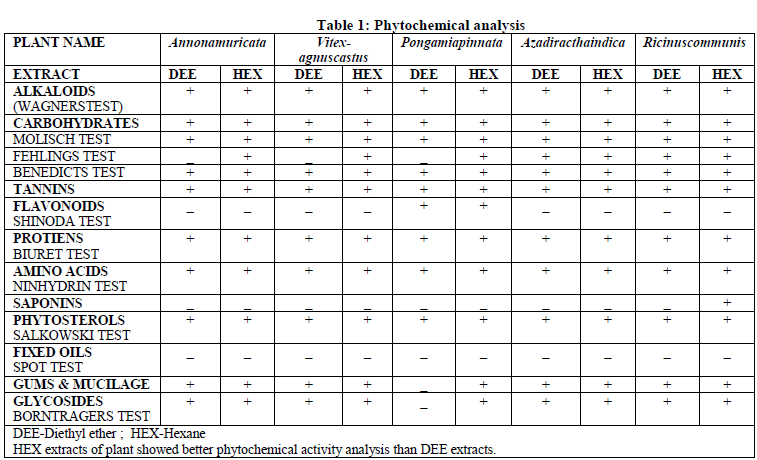 |
| The phytochemical analysis of the selected plants were performed and the results were tabulated according to the presence or absence of the phytochemicals inthe leaves of the plants. ‘+’ indicates the presence of the phytochemicals and ‘–‘indicates the absence of the phytochemicals. |
| QUANTITATIVE ANALYSIS IN PLANTS |
| ANTIOXIDANT ACTIVITY |
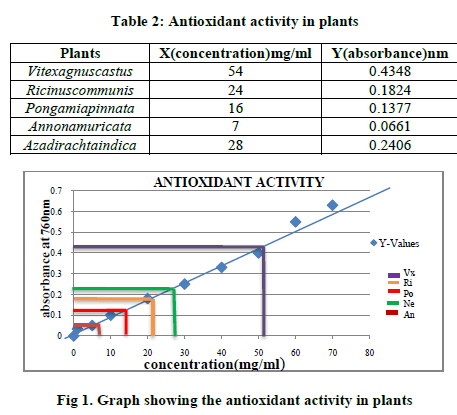 |
| The antioxidant activity was higher in Vitexagnuscastus than other plants. It possessed 54 mg/ml in it and Azadirachtaindica possessed lower antioxidant activity of 28 mg/ml. |
| FLAVONOID ACTIVITY |
 |
| The plants were performed with Flavonoid activity at 415 nm and the absorbance was recorded |
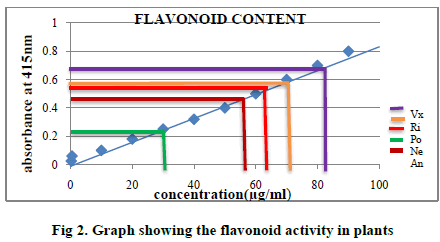 |
| The flavonoid content was higher in Vitexagnuscastus than other plants. It possessed 82 μg/ml flavonoid content in it and Azadirachtaindica possessed lower flavonoid activity of 30 μg/ml. |
| PHELOLIC ACTIVITY |
| Table 4: Phenolic activity in plants |
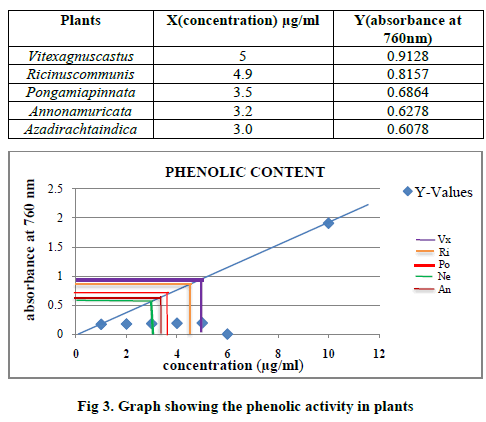 |
| The phenolic content was higher in Vitexagnuscastus than other plants. It possessed 5 μg/mlphenolic content in it and Azadirachtaindica possessed lower phenolic activity of 3μg/ml. |
| OVICIDAL ACTIVITY |
| The ovicidal activity was performed by treating the collected eggs with the prepared extracts, Diethyl ether and Hexane extract and the eggs hatchment was calculated. |
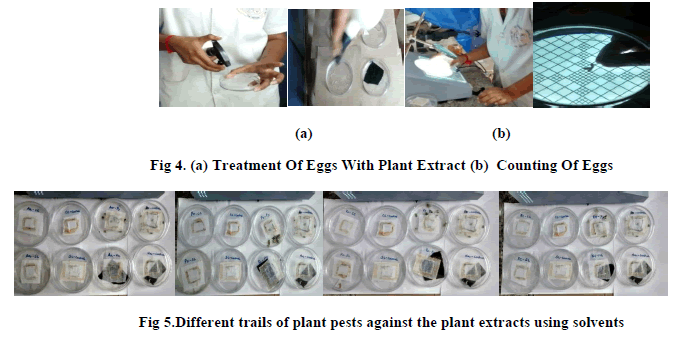 |
| Trials performed against the collected plant pests using the extracts for the ovicidal activity. |
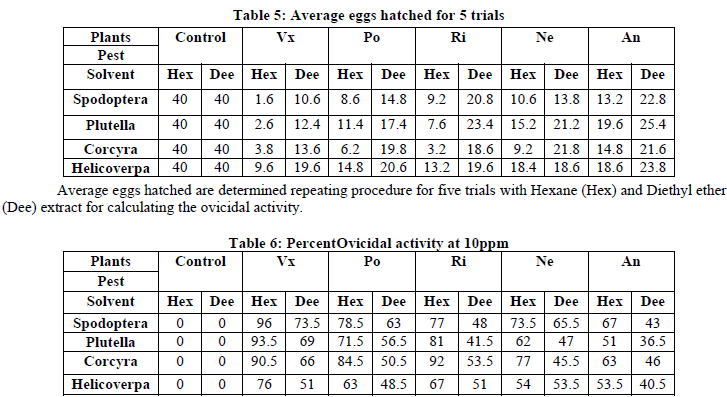 |
| In Earlier studies Vitexnegundo(52.02%) showed maximum ovicidal activity against Spodopteralitura at concentration of 0.05%[20]. In this study, Maximum ovicidal activity of 76.74 and 67.39% was noticed in PONNEEM. Ovicidal activity at 10ppm is calculated for different plants with HEX & DEE extracts on selected insect. In which hex extracts showed best result than dee extracts specifically hex extracts of Vitex, Pongamia,Ricinusplants showed highest values. |
 |
| The maximum activity at 10ppm was exhibited by hexane extract of Vitexagnuscastus ic50 (5.2 ) against Spodopteralitura,Plutellaxylostellaic50( 5.3 ),Corcyra cephalonica ic50(5.5 ) followed by Ricinuscommunis ic50( 5.4 ), against Corcyra cephalonicarespevtively and Pongamiapinnata ic50(5.9) against Corcyra cephalonica . Diethyl ether extracts showed lower ovicidal activity when compared to hexane extracts. |
 |
| Mean chart of IC50 values are determined using xlstat 2015 for calculating highest & lowest values using the Hex and Dee extracts for various plants determined against control.The hatchability of S. lituraeggs was directly proportional to the concentration of plant extract. |
 |
| By using the ANOVA software, analysis of variance, Degrees of freedom, Probability factor were determined. |
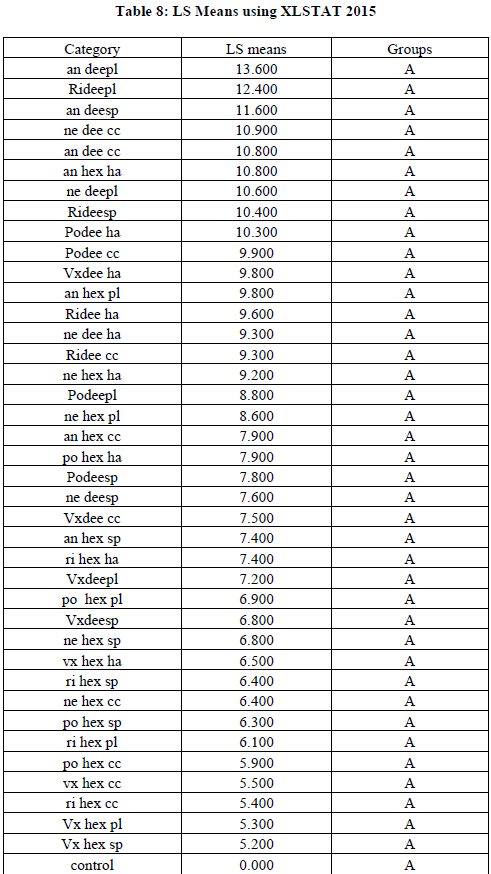 |
| The LS (Least square) means was calculated by using ANOVA Statistics 2015 using Tukey’s multiple range test. |
CONCLUSION |
| Chemical and synthetic pesticides used for controlling various plant pests have resulted in the development of resistance to several classes of pesticides. Ovicidal activity of plant extracts is important to control the pest at eggs stage itself thereby preventing the damage caused by other stages. Five plant extracts were been tested for the ovicidal activity against Spodopteralitura, Plutellaxylostella, Corcyra cephalonica, Helicoverpaarmigera. In this study clearly it was observed that all the treatments exhibited ovicidal activity against plant pests and the maximum activity at 10ppm was exhibited by hexane extract of Vitex-agnuscastus IC50 (5.2 ) against Spodopteralitura, Plutellaxylostella IC50 (5.3),Corcyra cephalonica IC50(5.5 ) followed by Ricinuscommunis IC50(5.4), against Corcyra cephalonicarespevtively and Pongamiapinnata IC50(5.9) against Corcyra cephalonica.Diethyl ether extracts showed lower ovicidal activity when compared to hexane extracts. |
ACKNOWLEDGEMENT |
| The authors record their sincere thanks to Dr. V. PALANI, Managing Director of Genewin Biotech, Hosur for providing necessary laboratory facilities to carry out this work in his DBT certified laboratory. |
References |
|